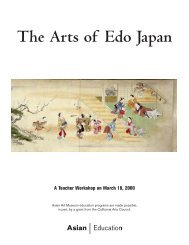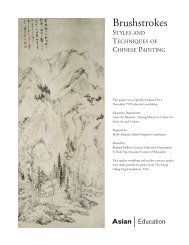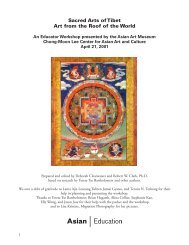China:The Glorious Tang And Song Dynasties - Asian Art Museum ...
China:The Glorious Tang And Song Dynasties - Asian Art Museum ...
China:The Glorious Tang And Song Dynasties - Asian Art Museum ...
You also want an ePaper? Increase the reach of your titles
YUMPU automatically turns print PDFs into web optimized ePapers that Google loves.
In the middle of the second century BCE, Confucianism was established as the official state ideology.<br />
However, during the <strong>Tang</strong> and <strong>Song</strong> dynasties influences from Daoism and Buddhism significantly<br />
challenged the dominant status of Confucian ideology. Confucian scholars met this challenge<br />
by integrating elements of both Daoist and other native philosophies into a single integrative ideology<br />
known as Neo-Confucianism. Neo-Confucianism can be described as the culmination of an<br />
effort to integrate and harmonize several different religious and philosophical traditions that had<br />
developed in <strong>China</strong> over the preceding thousand years, and as a way of making sense of several<br />
diverse and sometimes competing philosophies. <strong>The</strong> Confucian emphasis on principles such as<br />
“humaneness,” “filial piety,” and “ritual” was integrated with more abstract Daoist notions of a “the<br />
Way” (Dao) that governed all existence, as well numerous Buddhist principles.<br />
Neo-Confucianism is perhaps an expression of the Chinese tendency to seek “harmony” in all<br />
things—in this case, to try to synthesize complex religious and philosophical views. What resulted<br />
was a highly syncretic philosophy that was often very technical in nature; some ancient texts even<br />
present what might be described as flowcharts for their readers! Yet seemingly opposed ideas were<br />
unified by the notion of li, literally meaning “pattern,” or more specifically the “patterned markings<br />
of a stone,” but usually translated as “principle.” Neo-Confucians sought to uncover the “pattern” of<br />
all things, and firmly believed that all phenomena, including life, nature, destiny, indeed the<br />
entirety of existence, were essentially a “pattern” that could be discerned if closely examined. This<br />
fundamental premise, many people believe, underlay the <strong>Song</strong> interest in all things “scientific,”<br />
minute, and even trivial—since even the smallest entity had the potential to reveal the underlying<br />
pattern or li of all things.<br />
<strong>The</strong> forerunner of the Neo-Confucist movement was an orthodox Confucian named Han Yu,<br />
who also authored “<strong>The</strong> Girl of Mt. Hua” passage quoted above. In the later <strong>Tang</strong>, Han Yu unsuccessfully<br />
protested the emperor’s zealous commitment to Buddhism. Han Yu’s protest failed but his<br />
ideas inspired <strong>Song</strong> Confucian thinkers. <strong>Song</strong> philosophers assimilated certain elements of<br />
Buddhism and Daoism in order to revitalize Confucianism. <strong>The</strong>ir efforts gradually restored the<br />
supremacy of Confucianism in <strong>China</strong>. <strong>The</strong> most important of these <strong>Song</strong> scholars were the Cheng<br />
brothers and Zhu Xi.<br />
CHENG HAO (1032–1085) AND CHENG YI (1033–1107)<br />
Cheng Hao was one of the most successful and renowned Confucian philosophers in <strong>China</strong>. When<br />
he was young, Cheng Hao studied with a Confucian scholar named Zhou Dunyi, under whose<br />
tutelage Cheng attempted to acquire all knowledge available to him: not only Confucian but also<br />
Daoist and Buddhist teachings. He was an individual of great ambition. He passed the civil service<br />
exam in 1057 and enjoyed a successful official career. His younger brother, Cheng Yi, failed the civil<br />
service exam and for most of his life rejected Confucian court service in favor of contemplation of<br />
“the Way” (Dao). Together the two brothers formulated metaphysical theories concerning the relationship<br />
between li (the Confucian principle of social order) and qi (the Daoist principle of vital<br />
energies). Simply put, the Cheng brothers conceived of li and qi as the two fundamental elements<br />
constituting a single metaphysical entity. This syncretic theory became the foundation for the rise of<br />
Neo-Confucianism.<br />
13
















